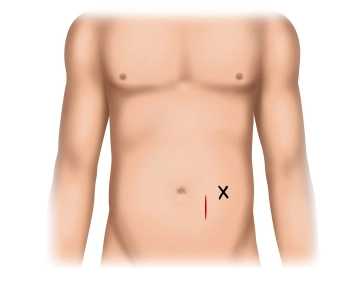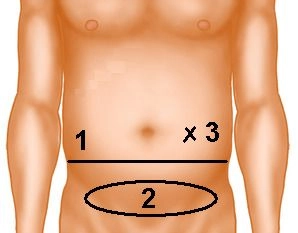Pararectal skin incision of about 6 cm inferior to the line connecting the umbilicus with the marked catheter exit. Divide the subcutaneous tissue by electrosurgery and expose the anterior lamina of the rectus sheath.
-
Incising the pararectal skin and exposing the anterior rectus sheath lamina
-
Exposing the posterior rectus sheath lamina and dividing the peritoneum
![Exposing the posterior rectus sheath lamina and dividing the peritoneum]()
Soundsettings Incise the anterior lamina of the rectus sheath in a sagittal direction and dissect the rectus muscle in blunt fashion. Open the peritoneum superior to the arcuate line and preplace a peritoneal suture (PDS 3/0) at the inferior pole of the incision.
Tip:
- For better stability, the catheter should be inserted superior to the arcuate line.
- Use a monofilament suture when closing the peritoneum and anchoring the catheter because this helps avoid suture hole laceration.
Placing the dialysis catheter and closing the peritoneum
Insert the CAPD catheter into the Douglas pouch with dressing forceps. When closing the peritoneum
Insert the CAPD catheter into the Douglas pouch with dressing forceps. When closing the peritoneum
Activate now and continue learning straight away.
Single Access
Activation of this course for 3 days.
US$9.40
inclusive VAT
Most popular offer
webop - Savings Flex
Combine our learning modules flexibly and save up to 50%.
from US$7.29 / module
US$87.56/ yearly payment
general and visceral surgery
Unlock all courses in this module.
US$14.59
/ month
US$175.10 / yearly payment



